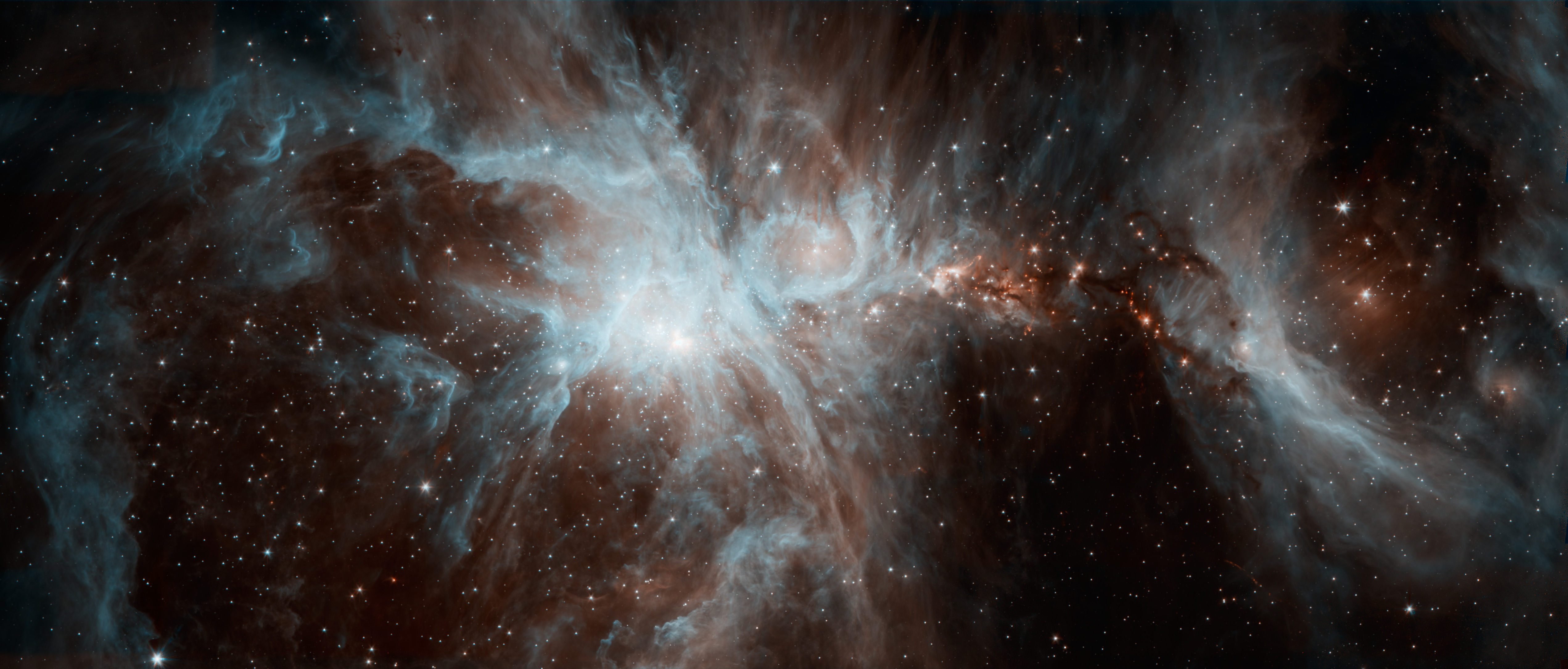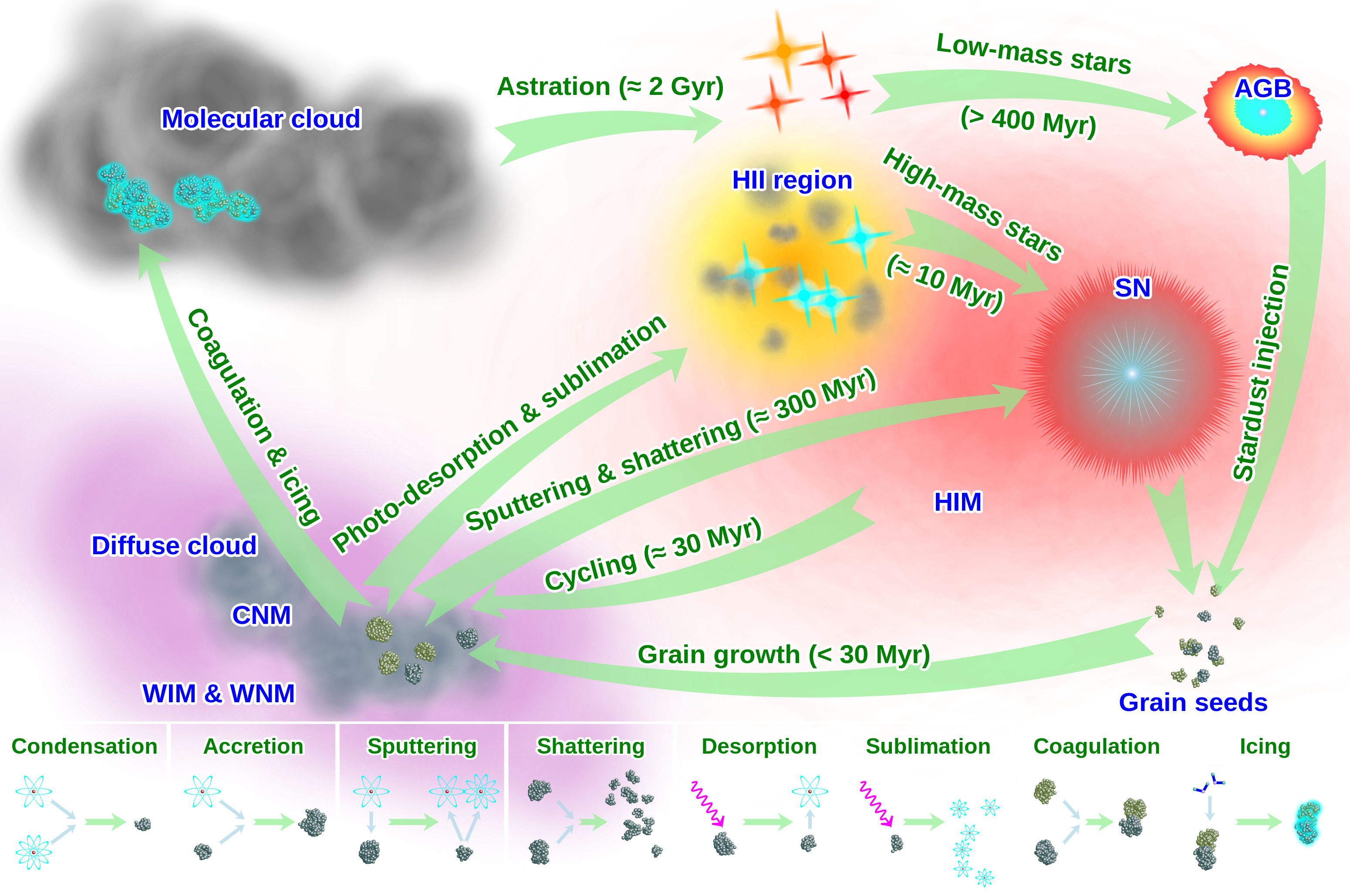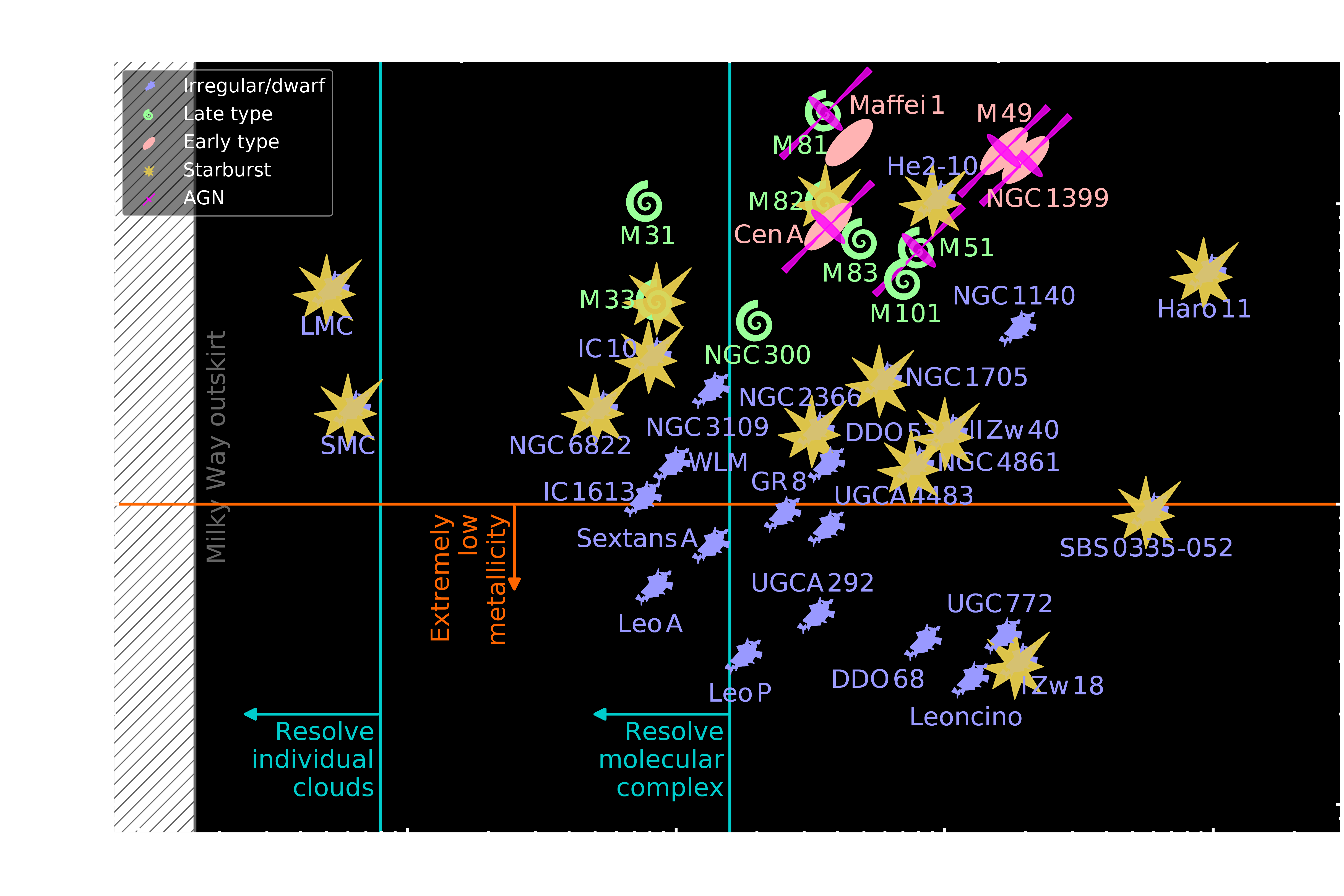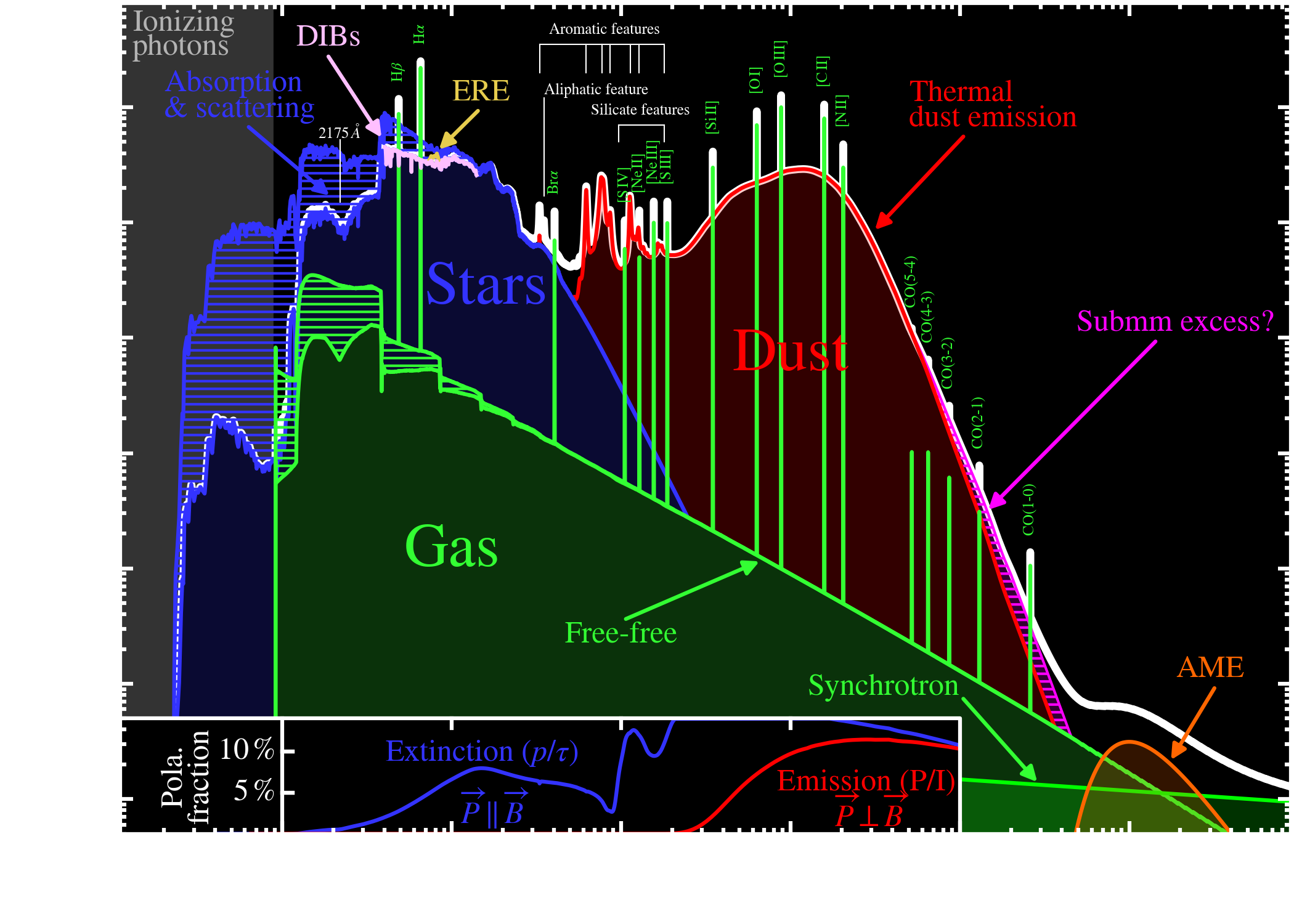RESEARCH ACTIVITY
1. SCIENTIFIC INTERESTS
1.1. The Interstellar Medium
My research activity revolves around the InterStellar Medium (ISM). The ISM is the complex intertwining of gas phases that fills the volume of a galaxy, between its stars. As an illustration, Fig. 1 shows an image of the Orion nebula. We can clearly see stars mixed with swirls of dusty gas. Stars are born out of the gravitational collapse of interstellar clouds. At the end of their lifetime, stars return a significant fraction of their matter to the ISM, whether exploding as supernovae or gently expelling their envelope as planetary nebulae. This is why we talk about an interstellar lifecycle, as stars deplete and replenish the interstellar matter reservoir. Each successive generation of stars also enriches the ISM in heavy elements (C, N, O, Fe, etc.), changing its thermodynamic and radiative properties. This cycle is however not endless. Young galaxies (irregular galaxies) are gas-rich, whereas old galaxies (elliptical galaxies) are almost totally devoid of interstellar gas, because most of it is locked in old stars.

The interstellar lifecycle is thus what drives the evolution of a galaxy. Yet, the process of star formation and its impact in return on the ISM is still poorly known. This is a major open question in modern astrophysics. This is important because our understanding of galaxy evolution, from the dark ages to the contemporary epoch, determines our understanding of the evolution of the Universe. My research work is aimed at tackling some particular aspects of this cycle.
1.2. Cosmic Nanoparticles
I focus my research on cosmic nanoparticles, also vulgarly called dust. These particles are small, solid-state compounds made of the most abundant heavy elements in the ISM (C, O, Si, Mg, Fe, etc.) arranged predominantly in silicate and carbonaceous compounds. The size of these grains ranges in the ISM from a few Å (a few atoms) to a few 100 nm. Cosmic nanoparticles account for less than 1% of the mass of the interstellar matter, but they have a crucial role in several physical processes.
- They extinct the UV-to-near-InfraRed (IR; λ≅100 nm to λ≅1 μm) light emitted by stars. The absorbed power is re-emitted thermally in the infrared/submillimeter (λ≅3 μm to λ≅800 μm). For instance, the interstellar emission in Fig. 1 comes mainly from the grains. The gas emission is much dimmer. For that reason, star forming regions are totally opaque at UV and visible wavelengths. The stellar radiation can not escape their interstellar dusty cocoon. These regions have to be studied via their dust emission, in the IR.
- Dust grains play an important role in the heating and cooling of the neutral gas. Grain surfaces are also catalysts to chemical reactions, forming molecules, including the most abundant one in the Universe, H2.
- Because of their ubiquity, and the high power they radiate, cosmic nanoparticles are used as proxies to studying numerous phenomena, including star formation.

The physical properties of these cosmic nanoparticles are not well constrained. We do not precisely know their exact composition, size distribution and shape. Moreover, there is clear evidence that these physical properties evolve as a function of the environment, under the effects of stellar radiation, gas density, shocks and metallicity. The dust lifecycle, describing how grains are formed, processed and destroyed in the ISM is schematically represented in Fig. 2. An important part of my work consists in constraining the timescales of the individual processes that are represented.
1.3. Nearby Galaxies
The dust lifecycle can be studied from different viewpoints. It however requires an empirical approach. Most of my research work focuses on nearby galaxies for the following reasons.
- They are close enough to be studied with a lot of details and accuracy. In the closest ones, the Magellanic clouds, we can resolve individual clouds with modern infrared observatories. More distant galaxies do not provide this luxury, but they bring a more statistical view on ISM properties.
- Nearby galaxies show a wide diversity of physical conditions, as represented in Fig. 3. In particular, they have a large range of star formation activity, some being quiescent, other undergoing a starburst. They also span two orders of magnitude in metallicity, the mass fraction of heavy elements. Metallicity is a chemical age tracer. Low-metallicity galaxies, which happen to be dwarf galaxies, are the best local analogues to distant primordial systems.
By modeling nearby galaxies, one can better understand dust evolution, if one considers each object as a snapshot of galaxy evolution at a given stage.

2. METHODOLOGICAL APPROACH
2.1. Spectral Energy Distribution Modeling
Most of the physical information is contained in spectra. A spectrum is the power emitted per unit wavelength (or photon energy). The spectrum of a typical galaxy is shown in Fig. 4. We see that there is a continuum emission, varying smoothly as a function of wavelength, originating from different processes (stellar emission, dust emission, etc.). There are also several lines, with sharp spikes of energy in a very narrow wavelength band. These lines originate in the resonance of electrons in atoms or molecules. The shape and level of the continuum, as well as the intensity, width and central wavelengths of gas lines, contains a wealth of information about the physical conditions in the observed region. Historically, it is spectroscopy that transformed astronomy into astrophysics, as it allowed scientists to quantify the temperature, density, physical state, abundances of atoms from very far away.

When the spectrum is only coarsely sampled, we rather talk about Spectral Energy Distribution (SED), but it is the same thing. The SED of the galaxy represented in Fig. 4 covers a large part of the electromagnetic spectrum, from the UV to the centimeter radio wavelengths. Photons with wavelengths shorter than λ=0.0912 μm are able to ionize hydrogen. They are emitted by the most massive stars, which also happen to be the hottest ones. Stellar emission dominates the UV-to-near-IR range. In the IR, thermal emission from dust grains dominates. These grains are on average at 20 kelvins, 20 degrees above the absolute 0. Gas lines are emitted over the whole electromagnetic range and the gas continuum dominates mainly at radio wavelengths.
A lot of the information about the grain properties can be inferred from their IR emission. This is a large part of my activity. I develop SED models to interpret IR observations of galaxies. Comparing models to observations is however not a straightforward matter. There is an immense literature on the subject.
2.2. Bayesian Methods
Inferring physical quantities from observations, that are fatally tainted by uncertainties, requires a statistical framework. There are two philosphies: the frequentist and Bayesian approaches. For a complete discussion about these two methods, I refer the reader to Chapter V of my HDR. In brief, the advantage of the Bayesian method, which I favor, allows one to derive the probability distribution of physical parameters, accounting for all the sources of observational uncertainty. I wrote a computer code to achieve this goal as accurately as possible, in the case of IR SED fitting: HerBIE (HiERarchical Bayesian Inference for dust Emission; Galliano, 2018).
2.3. Other Methods
I also work with other methods. I have followed the recent interest in machine-learning techniques. I worked with several students applying them to ISM questions. In particular:
- Optimizing dust SED models with machine-learning methods (Tedros & Galliano, in prep.);
- Using Natural Language Processing to automatically explore the literature looking for molecules that could explain DIBs (van den Broek d'Obrenan et al. 2023, JIMIS, vol. 11).
This last study was quite original, as we showed that some molecules found in the eye pigments of several sea animals contained molecular groupings of interstellar interest (chromophores) that could account for several DIBs.
3. CURRICULUM VITAE & SELECT PUBLICATIONS
3.1. Short Curriculum Vitae
3.1.1. Education
- January 2022:
- habilitation (HDR; Université Paris-Saclay).
- April 2004:
- PhD (Université Paris XI), prepared at the Service d'Astrophysique, CEA Saclay.
- June 2000:
- Master's degree (DEA; Université Paris XI) in Astrophysics and Space Technics.
3.1.2. Positions
- October 2008 – present:
- chargé de recherche (CNRS) at the Département d'Astrophysique, CEA Paris-Saclay.
- June 2007 – September 2008:
- postdoc at University of Maryland, College Park.
- June 2004 – May 2007:
- postdoc at NASA Goddard Space Flight Center, laureate of a National Research Council (NRC) fellowship.
- October 2000 – December 2003:
- PhD student at the Service d'Astrophysique, CEA Saclay, laureate of a Contrat de Formation par la Recherche (CFR).
- March 2000 – July 2000:
- intern at the Département d'Astrophysique Extragalactique et Cosmologie, Observatoire de Meudon.
3.1.3. Main administrative responsibilities
- January 2023 – present:
- director of the Astrophysics Axis of the Graduate School of Physics, at Paris-Saclay University.
- July 2022 – present:
- member of the DAp laboratory council.
- February 2021 – present:
- member of the DAp scientific communication committee.
- January 2020 – present:
- chair of the organizing committee of the DAp seminars.
- July 2013 – December 2021:
- member of the scientific council of PCMI.
- October 2009 – February 2021:
- representative of the DAp office management committee.
- April 2009 – December 2019:
- organizer of the Star Formation Lunch seminars, at DAp.
3.2. Most Notable Articles
3.2.1. Publications in Scientific Journals
- Exhaustive publication list:
- ORCID.
- Most notable papers
- by inverse chronological order:
- A nearby galaxy perspective on dust evolution. Scaling relations and constraints on the dust build-up in galaxies with the DustPedia and DGS samples, F. Galliano, A. Nersesian, S. Bianchi, et al., 2021, Astronoym & Astrophysics, volume 649, article A18, 42 pages (open access PDF).
- The Interstellar Dust Properties of Nearby Galaxies, F. Galliano, M. Galametz & A. P. Jones, 2018, Annual Review of Astronomy and Astrophysics, volume 56, pages 673-713 (open access PDF).
- A dust spectral energy distribution model with hierarchical Bayesian inference - I. Formalism and benchmarking, F. Galliano, 2018, Monthly Notices of the Royal Astronomical Society, volume 476, pages 1445-1469 (open access PDF).
- Non-standard grain properties, dark gas reservoir, and extended submillimeter excess, probed by Herschel in the Large Magellanic Cloud, F. Galliano, S. Hony, J.-P. Bernard, et al., 2011, Astronomy and Astrophysics, volume 536, article A88, 32 pages (open access PDF).
- Variations of the mid-IR aromatic features inside and among Galaxies, F. Galliano, S. C. Madden, A. G. G. M. Tielens, et al., 2008, The Astrophysical Journal, volume 679, pages 310-345 (open access PDF).
- Stellar Evolutionary Effects on the Abundances of Polycyclic Aromatic Hydrocarbons and Supernova-Condensed Dust in Galaxies, F. Galliano, E. Dwek & P. Chanial, 2008, The Astrophysical Journal, volume 672, pages 214-243 (open acess PDF).
- ISM properties in low-metallicity environments. III. The spectral energy distributions of II Zw 40, He 2-10 and NGC 1140, F. Galliano, S. C. Madden, A.P. Jones, et al., 2005, Astronomy and Astrophysics, volume 434, pages 867-885 (open access PDF).
- ISM properties in low-metallicity environments. II. The dust spectral energy distribution of NGC 1569, F. Galliano, S. C. Madden, A. P. Jones, et al., 2003, Astronomy and Astrophysics, volume 407, pages 159-176 (open access PDF).
3.2.2. Habilitation Thesis (HDR)
My HDR (Habilitation à Diriger des Recherches; 2022) provides a good introduction to my research fields. It is written like a textbook (353 pages, 165 original figures). It contains didactic introductory sections, an historical perspective, some epistemological viewpoints and the main concepts necessary to understand the contemporary publications about interstellar dust: PDF or HTML1.
3.2.3. Outreach
- Explorer l'écosystème interstellaire: outreach article on The Conversation (in French).
- L'écosystème interstellaire, outreach article in Clefs CEA, 69, page 21-22, F. Galliano, P. Hennebelle & V. Lebouteiller.
- Les Galaxies : une évolution pleine de paradoxes: outreach article in Clefs CEA, 58, page 44-47 M. Sauvage & F. Galliano.
3.3. Recent Talk Slides
3.3.1. Select reviews & contributed talks
- A Nearby Galaxy Perspective on Interstellar Dust Properties and their Evolution HDR defense, Université Paris-Saclay, in 2022.
- A Nearby Galaxy Perspective on Dust Evolution seminar given during a Supernova Teletalk, in 2020, presenting results of the DustPedia project.
- Hierarchical Bayesian Inference - Its Application to Dust Emission Modelling talk given at the Institut Pascal, in 2019, during the AstroDat meeting, presenting my approach to modelling astrophysical data.
3.3.2. Lectures
- The Interstellar Medium – Lecture 1 – An Overview of the ISM & the Way We Study It, lecture given at the 45th International School for Young Astronomers, in Algiers in 2024.
- The Interstellar Medium – Lecture 2 – Atoms, Molecules & Dust, lecture given at the 45th International School for Young Astronomers, in Algiers in 2024.
- The Interstellar Medium – Lecture 3 – Heating & Cooling – The Phases of the ISM, lecture given at the 45th International School for Young Astronomers, in Algiers in 2024.
- From Astronomy to Astrophysics – How do we explore regions of space that we can not currently reach, lecture given to European engineering students, at The Course, a spring school organized by BEST ENSTA, in 2024.
- The Interstellar Dust Properties and their Evolution in Galaxies lecture given at the Ecole Doctorale d'Astronomie & Astrophysique d'Île de France, in 2022, consisting in an introduction to interstellar dust and its application to galaxies.
3.3.3. Astromind talks
Astromind is a monthly informal meeting at DAp Paris-Saclay, where we discuss a wide variety of topics.
- A Brief History of Unit Systems - Or Why Units do Not Always Mean Unity, in 2022, being the starting point of a discussion about unit systems.
- How to Account for All Experimental Facts with a Wrong Model: the Ultra-Mundane Corpuscular Theory of Gravitation, in 2022, presenting the forgotten theory of gravitation by Georges LESAGE.
- The Quantification of Beliefs, from Bayes to A.I., and Its Consequence on the Scientific Method, in 2019, presenting a review on the epistemological implications of the Bayesian method.